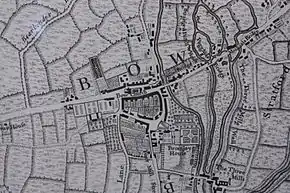Bow Bridge (London)
Bow Bridge was a stone bridge built over the River Lea, in what is now London, in the twelfth century. It linked Bow in Middlesex with Stratford in Essex.
_p18b_-_Bow_Bridge.jpg.webp)
In 1110 Matilda, wife of Henry I, ordered a distinctively bow-shaped (arched) bridge to be built over the River Lea, together with a causeway across the marshes along the line now occupied by Stratford High Street. Historical reports[1] state she (or her retinue) encountered problems crossing the river to get to Barking Abbey.
The river was previously forded further north at Old Ford; the new crossing led the highway to Essex and East Anglia to take a more southerly route - now the Whitechapel, Mile End and Bow Roads.[2]

Prior to the construction of the bridge, settlements on both sides of the river were known as Stratford. Afterwards, the western Stratford then become suffixed by “-atte-Bow” (at the Bow), eventually becoming known simply as Bow, while over time the eastern Stratford lost its “Langthorne” suffix.
Maintenance
Initially, local land and Abbey Mill were given to Barking Abbey for the maintenance of the bridge, but these properties and the responsibility eventually passed to Stratford Langthorne Abbey. The Abbess of Barking and Abbot of West Ham (i.e. Stratford Langthorne Abbey) argued about the obligation, a dispute that was settled in 1315. West Ham was to maintain the bridge and highway, but the Abbess would pay £200 annually in recompense. The Abbey's subsequent dissolution caused further lengthy litigation over maintenance of the bridge at Bow – with the successor landowners found responsible in 1691.[3] The matter was not finally resolved until 1834, with the formation of a Turnpike Trust.
Battle of Bow Bridge
The Bridge and the surrounding area was the site of a minor battle in 1648, during the second English Civil War. After the battle the Royalist force moved to Colchester where it was subsequently besieged and defeated.[4]
Demolition
The Bridge was repaired and upgraded many times over the centuries until eventually demolished and replaced in 1838-39.
References
- "Stratford-le-Bow | British History Online". www.british-history.ac.uk.
- The London Encyclopaedia, Weinreb and Hibbert, 4th Edition, 1983
- Houses of Cistercian monks: Abbey of Stratford Langthorne, A History of the County of Essex: Volume 2 (1907), pp. 129-133 accessed: 30 April 2008.
- The campaign covered briefly in The English Civil War, A peoples History. Diane Purkiss. p534-6